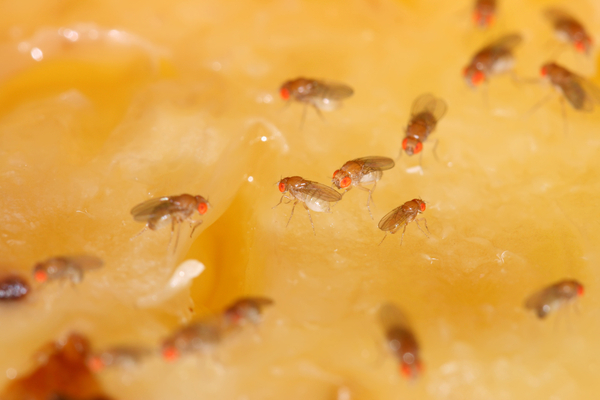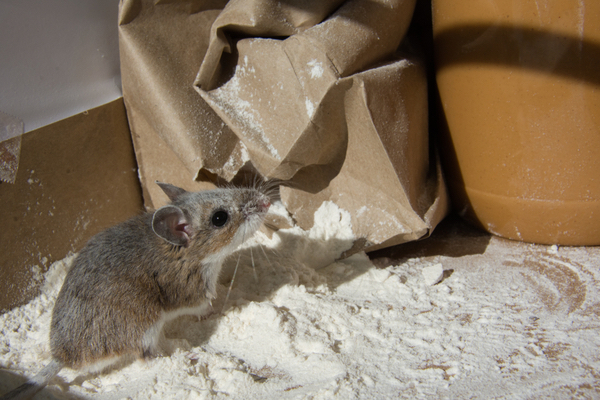Most pests at least have the common courtesy to hide in your basement most of the time. Not kitchen pests, though. Oh no. Kitchen pests are a special kind of upsetting. They come after YOUR FOOD. You could end up biting into your favorite snack only to find something… considerably less appetizing inside.
Yeah. That’s just untenable. The last thing you want to is to be paranoid about the food you eat every day. To avoid that situation, you have to do everything you can to keep pests out of your kitchen. We’re here to help. These are the four most common kitchen pests in Michigan, and how to keep them out of your food.
Indian Meal Moth
There are several species of pantry moths that will wreak havoc on your stored food. The most common and problematic of these pests is the Indian meal moth. Indian meal moths lay eggs in dry, stored food like cereal, bread, and sugar. When these eggs hatch, Indian meal moth larvae feed on your food continuously. In the process they produce waste and excrete a fine, web-like silk. Indian meal moths inflict a surprising amount of damage to your food, and they inflict it surprisingly quickly.
Indian meal moths generally get into your home when you accidentally bring them in on food packaging. Adults are brown or tan and tend to blend in with brown paper bags or packages. Larvae can chew through cardboard and some plastic, and often sneak into boxes. Check your groceries carefully before you bring them inside. Don’t buy food items with damaged packaging. Clean your pantry regularly to prevent crumb build-up and clutter.

Fruit Flies
Fruit flies are attracted to organic foodstuffs that’s ripe, fermenting, or moist in any other way. The food that attracts fruit flies constantly produces a thin film of moisture that coats its surface. Fruit flies lay their tiny eggs inside this thin layer of moisture. A single fruit fly can lay up to 500 eggs, and the flies complete their life cycle very quickly. Unfortunately, that means fruit fly infestations grow rapidly. Virtually any amount of food moisture will foster fruit fly eggs.
To keep fruit flies out of your home, you have to deprive them of nesting environments. Pay close attention to where you’re keeping your food. Never leave fruits or vegetables sitting out in the open for extended periods of time. Store fruit and vegetables in their appropriate fridge cabinets, and keep them in bags. Clean surfaces thoroughly after preparing meals and eating. Fruit flies are also attracted to garbage, so make sure you take your garbage out regularly.
Cockroaches
The most common cockroach in Michigan is the German cockroach. Roaches are attracted to dark, moist areas where they can feed in peace. Generally, you’ll find them under your sink or in and around your garbage. They may also congregate around spills or puddles you didn’t find fast enough, especially in your pantry. Roaches contaminate any food they come into contact with. They’re also capable of spreading potentially dangerous pathogens like E. Coli.
Roaches are attracted to moisture, especially in dark and messy places. As always, garbage duty should be your first consideration. Make sure you store your garbage in a tidy, sealable plastic bag. Thoroughly rinse and dry food containers before you throw them away. You should also clean out the space beneath your sink frequently and check for leaks or puddling. Cockroaches don’t need much moisture, and they’re very attracted to humidity. Keeping your kitchen clean will help keep them away.

Rodents
Yes, every home’s eternal nemesis is also a particularly common kitchen pest. Rats and mice find hidden or secluded routes through your home into your kitchen. They follow utility pipes, squeeze through holes in cabinets, or just run beneath furniture. Once they reach your food, they chew holes through packaging to munch on whatever they can. In the process, they often contaminate a lot of food at once. Rodents can also carry and transmit diseases.
Rodents will pretty much always be able to smell your food, but you can stop them from getting it. Keep your stored food in airtight, hard plastic containers. Clean out your cabinets and pantry frequently to prevent crumbs. Wipe down kitchen counters and dining tables after every meal. As always, take your garbage out frequently, and make sure you don’t leave any behind. Patch up holes leading into your food areas, especially around pipes and other utility lines.
If you find a pest in your kitchen, it’s important to act fast. The longer you wait, the more extensive kitchen infestations tend to become. There’s also the psychological factor: no one deserves to be afraid of their own food!
Next time you notice a pest in your kitchen, give Griffin a call right away. We’ll be able to identify the full extent of your infestation and wipe it out just as quickly. You’ll be able to go back to using your kitchen without preparing meals for any unwanted guests.






 Garbage management
Garbage management It’s all-too-easy to depend on your drains, especially in the hectic restaurant world. You just pour the whatever-it-is down the drain and move on to your next task. The whatever-it-is is gone, and you can keep working! It’s perfect, right? Unfortunately, that’s not really how it works. The stuff you pour down the drain often stays in the drain, where it can rot, congeal, or build up. Before long, you could have a nasty clog–or worse.
It’s all-too-easy to depend on your drains, especially in the hectic restaurant world. You just pour the whatever-it-is down the drain and move on to your next task. The whatever-it-is is gone, and you can keep working! It’s perfect, right? Unfortunately, that’s not really how it works. The stuff you pour down the drain often stays in the drain, where it can rot, congeal, or build up. Before long, you could have a nasty clog–or worse. Unfortunately, this is another situation where restaurants are at a disadvantage. Think about how many doors and windows your restaurant has. There’s the front entrance for sure, a back entrance, probably a supply entrance, any emergency exits, and more. Pests can use these entrances, too. Then there are the restaurant-specific access points to worry about. Pests can come down ventilation just as easily as smoke and food smells can escape.
Unfortunately, this is another situation where restaurants are at a disadvantage. Think about how many doors and windows your restaurant has. There’s the front entrance for sure, a back entrance, probably a supply entrance, any emergency exits, and more. Pests can use these entrances, too. Then there are the restaurant-specific access points to worry about. Pests can come down ventilation just as easily as smoke and food smells can escape. This probably seems obvious to you, but spills can be tricky. We’re not just talking about the ones out on the dining floor. We’re talking about the spills that can go overlooked. The tiny
This probably seems obvious to you, but spills can be tricky. We’re not just talking about the ones out on the dining floor. We’re talking about the spills that can go overlooked. The tiny 